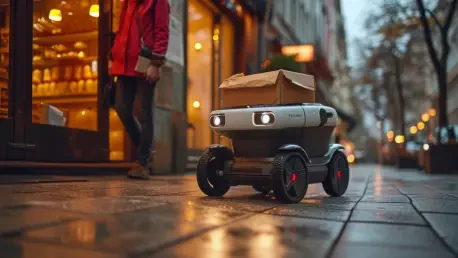In the bustling metropolis of Shenzhen, a groundbreaking initiative has unfolded, highlighting the cutting edge of urban logistics: autonomous delivery robots. These intelligent machines, akin to futuristic penguins, have ushered in a new era for transporting goods efficiently across the city using its extensive subway network. This deployment is a pivotal component of the city’s strategy to integrate service and industrial robots into everyday life, aiming for widespread adoption by 2027. As cities continue to grapple with increasing urbanization and the demand for sustainable logistics solutions, the emergence of these autonomous systems could redefine urban transport landscapes.
Understanding Autonomous Delivery Robots
The concept of autonomous delivery robots centers around self-navigating machines designed to operate without human intervention. Built with advanced sensors, mapping technologies, and communication interfaces, these robots are capable of interpreting their environments, making deliveries with precision, and avoiding obstacles seamlessly. Their entry into the logistics domain aligns with a global push toward automation, reflecting a shift from traditional manual delivery methods to more sophisticated, technology-driven solutions. With growing congestion and logistical demands in urban settings, these robots offer a promising alternative to address these challenges effectively.
Autonomous delivery robots are not just a technological marvel; they represent a significant step in the evolution of logistics and transportation. By enabling efficient last-mile delivery, these robots hold the potential to transform supply chains, optimizing delivery speed and reducing human labor costs. Their deployment in urban environments highlights the adaptation of infrastructure to support modern solutions, demonstrating a broader commitment to sustainable and efficient urban living.
Key Features and Components
Navigation and Mapping Systems
Autonomous delivery robots rely heavily on cutting-edge navigation and mapping systems to function autonomously and accurately. These systems utilize technologies such as LiDAR, GPS, and cameras to map environments in real-time, allowing robots to make informed decisions on routing, obstacle avoidance, and situational awareness. Such capabilities are crucial for ensuring the robots can deliver goods safely and efficiently, even in intricate urban settings like subways or crowded streets. The precision in navigation ensures that deliveries are not only accurate but also timely.
The significance of robust navigation systems cannot be overstated, as they form the backbone of the robots’ operational success. Accurate mapping allows the robots to adapt to dynamic environments swiftly, minimizing delivery errors and enhancing reliability. Successful deployment in urban settings showcases the potential for robots to navigate complex infrastructures, further solidifying their role in the future of logistics.
Communication and Interaction Capabilities
Communication and interaction features are essential for autonomous delivery robots as they operate within human-centric environments. These robots are equipped with sensors and communication arrays that enable them to interact with their surroundings, including other robots, infrastructure, and people. Equipped with safety protocols and public-friendly designs, like LED-lit faces, they communicate status and intentions, ensuring a seamless coexistence with human counterparts.
Robust interaction capabilities facilitate the safe integration of autonomous robots in public spaces. By engaging with their environments dynamically, these robots can adapt to unforeseen events, promoting smooth and efficient operation. Their ability to communicate effectively is pivotal in gaining public trust, which is essential for broader acceptance and integration into urban ecosystems.
Recent Developments and Trends
The field of autonomous delivery robots is witnessing rapid innovation and evolving trends, reflecting advancements in technology and shifting market demands. Recent developments include improvements in artificial intelligence algorithms, which enhance the robots’ decision-making abilities and efficiency in complex scenarios. An increasing focus on secure data handling and collaboration between robots is also noteworthy, as it underscores the importance of privacy and safety in automation.
Trends influencing the growth and adaptation of autonomous delivery robots include a marked shift in industry behaviors and consumer expectations. As online shopping rises, there is a growing demand for efficient and reliable last-mile delivery solutions, driving the need for advanced autonomous systems. Industry players are also focusing on developing durable and environmentally friendly robots, emphasizing sustainability alongside technological innovation.
Real-World Applications
Autonomous delivery robots are increasingly finding their place in real-world settings, marking their presence in various industries, particularly in urban logistics. Notable implementations can be observed in the retail sector, where robots are deployed to restock stores efficiently, as seen with partnerships involving firms like 7-Eleven. In industrial environments, these robots aid in the seamless transport of materials within facilities, enhancing overall productivity.
Groundbreaking applications extend beyond conventional logistics, showcasing the technology’s versatility. For instance, these robots are being tapped for roles in healthcare, where they deliver medical supplies and samples, showcasing their potential in critical, time-sensitive situations. Such implementations not only demonstrate the diverse capabilities of autonomous delivery robots but also highlight their transformative impact on improving operational efficiencies across sectors.
Challenges and Limitations
Despite the promising outlook, autonomous delivery robots face challenges that impact their widespread adoption. Technological hurdles, such as navigation in unpredictable environments and maintaining communication in signal-poor areas, present significant obstacles. Additionally, there are regulatory challenges, with varying degrees of acceptance and adaptation in different regions complicating deployment efforts.
Market obstacles also persist, as the cost of technology and infrastructure enhancement may hinder accessibility for smaller businesses. However, continuous development efforts and partnerships between technology firms and municipalities aim to address these challenges, focusing on achieving seamless integration into existing urban fabrics.
Future Outlook
The future trajectory of autonomous delivery robots points toward continued innovation and integration in urban logistics. Potential breakthroughs may arise from enhanced artificial intelligence capabilities and improved hardware, allowing for greater efficiency and adaptability. As technology continues to evolve, these robots are expected to play a crucial role in shaping logistics and related sectors, leading to smarter cities and sustainable urban living.
Advancements are likely to involve collaborations across industries, emphasizing interoperability and shared infrastructure. The long-term impact will extend beyond logistics, contributing to a more technologically advanced society where robots support various facets of daily life. As we move forward, continuous monitoring of this technology’s growth and adaptation will be essential for maximizing its benefits.
Closing Thoughts
In summary, the rise of autonomous delivery robots represents a monumental advancement in urban logistics and transportation systems. From efficient navigation systems to seamless interaction capabilities, these robots are poised to transform supply chains and optimize delivery processes significantly. The current challenges, while notable, are met with ongoing strategies aimed at overcoming barriers to adoption. Looking ahead, the continuous evolution in this field promises to reshape logistics landscapes, ushering in a new era of automation that redefines urban living and enhances the way goods are delivered and managed in metropolitan areas. As industries and cities capitalize on these technologies, the potential for innovation appears boundless, with autonomous robots set to play a pivotal role in the logistics sector’s future.









